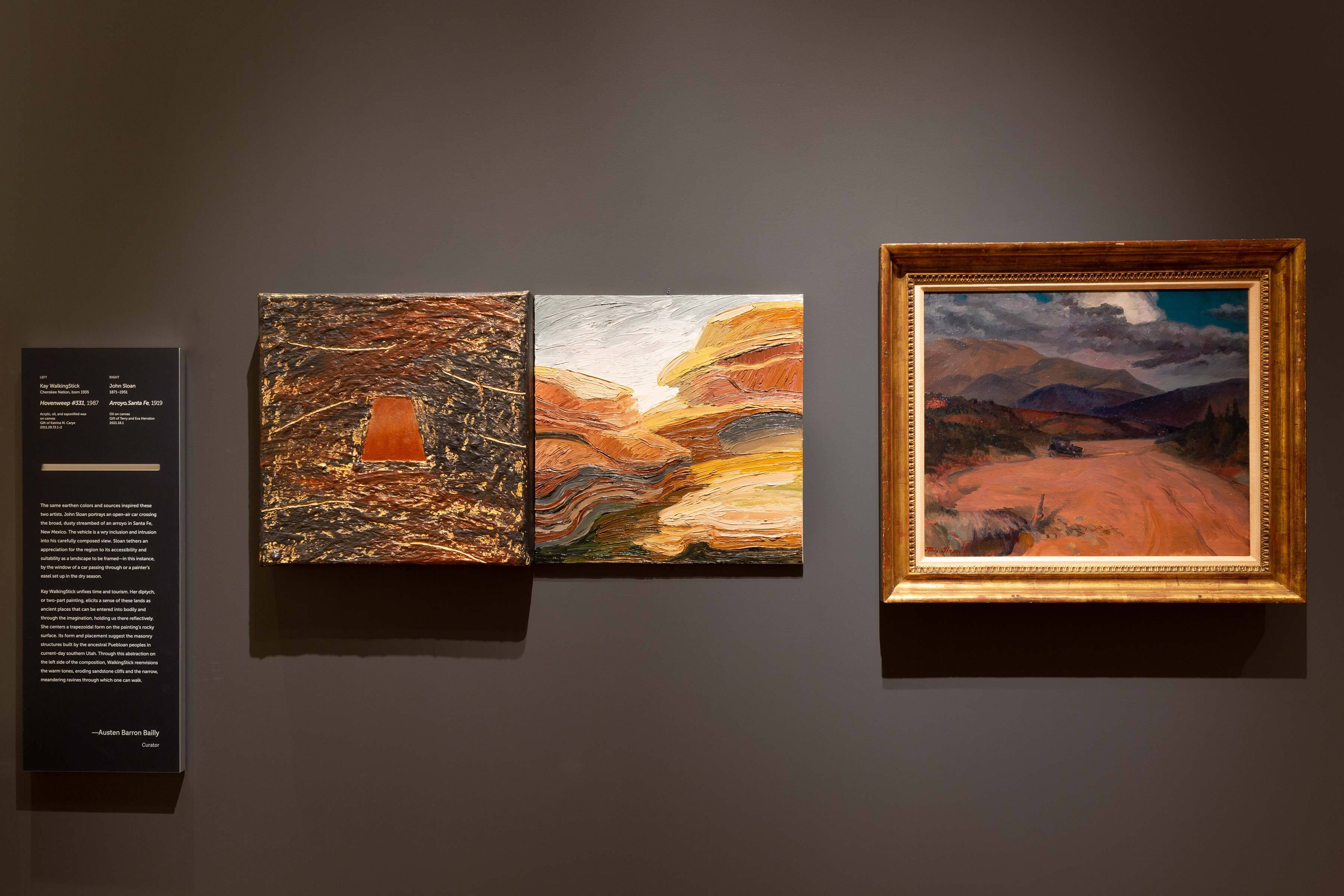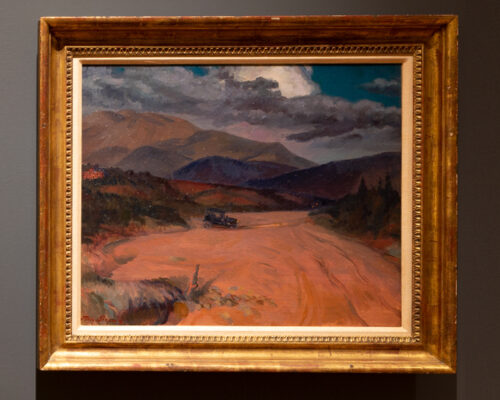
CONNECTED | Sep 16, 2025
Comparing two visions of Puebloan space and time
I first encountered John Sloan’s Arroyo, Santa Fe last fall, in PEM’s 2022 installation of their Native American and American collections, On This Ground: Being and Belonging in America, where it is displayed in conversation with Kay WalkingStick’s Hovenweep. The pairing struck me as particularly poignant — though both artists encourage you to see, WalkingStick truly asks you to feel.
On This Ground: Being and Belonging in America, Peabody Essex Museum. Photo by Kathy Tarantola/PEM.
Arroyo, Santa Fe, painted in 1919, may seem to be a more “traditional” landscape painting, as it favors realistic, believable imagery (often referred to as naturalism by art historians) and a wide field of view. These were trendy tactics for 20th-century painters, but the products (however visually pleasing) were often misleading. Landscape painters frequently avoided rendering Indigenous inhabitation, effectively denying Native existence. For instance, think of those massive, sweeping canvases by Albert Bierstadt and Thomas Moran. Sloan used similar techniques to depict Santa Fe as a plentiful, beautiful, but largely vacant land. Omitting Native peoples was a way to justify their ongoing displacement from pre-colonial homelands.
Arroyo, Santa Fe is situated in the heartlands of Puebloan territory in Oga Po’geh [Santa Fe], New Mexico. The city remains a hub for Native American arts, but is also a notable site of Puebloan resistance. It was there that the 1680 Pueblo Revolt, a tremendous moment of communal strength and coordination, drove Spanish colonists out of New Mexico for approximately 12 years. Numerous challenges followed, and Puebloan communities have continued to adapt and grow.


Despite centuries of Puebloan life at Oga Po’geh, Sloan offers only one adobe structure, small and distant, to indicate the presence of human inhabitation. He is invested in a different revolution: an early 20th-century car creeping into the empty arroyo — an often-dry streambed, or “wash,” typical of the American Southwest. The vehicle resembles a Ford Model T, alluding to the slew of mass-production innovations that had accelerated automobile usage by the 1910s. It is dwarfed by the surrounding mountains and framed by dark, looming clouds. I wonder, who is behind the wheel of this car? Why have they strayed into the arroyo? The anonymity of the car’s passengers and their intentions is, for me, a troubling preview of further ecological damage soon to come. By disrupting natural habitats, worsening air quality and polluting water sources, paved roads and automobile carbon emissions have introduced new threats to the plant life, wildlife and human life of the Southwest.
As Sloan prioritizes the visual, WalkingStick reminds us of experiential, bodily dimensions left unseen. In Hovenweep, and her wider artistic production, WalkingStick reveals the agency of the ever-shifting landscape. Hovenweep tells us that land is much more than an image; the land acts upon its inhabitants through sound, smell, touch and more.
This conversation extends across Puebloan space and time. Hovenweep was developed by Ancestral Pueblo peoples in the lands now known as Utah and Colorado. It is currently managed by the National Park Service and largely known for its “towers” — multi-level adobe buildings constructed with masonry. The site’s advanced construction is a testament to the Ancestors’ deep knowledge of land, passed down and carried forward by the Pueblos of today (see list at the end of this post).
In WalkingStick’s rendering, we are privy to rough, hard textures, rock shapes made by wind and time, and the layers of life baked into this land. Like Sloan, WalkingStick allows us to see the land’s visual beauty; its multicolored curves, layers and pathways. On the left, a geometric “tower” stands level and strong, seeming to emerge from and settle into its background simultaneously. The two sides differ, but are not at odds. They work together.

Image of Hovenweep, November 4, 2018, Wikimedia Commons. Author: Mobilus In Mobili
WalkingStick described her frequently used diptych (two-part) structure in ArtJournal in 1992: “The two portions represent two kinds of knowledge of the earth. One is visual, immediate and particular, the other is spiritual, long-term and nonspecific.” There is, indeed, a bustle of abstracted activity surrounding Hovenweep. When I consider my own ancestry here, I imagine the textures of relationships, spiritual activities and ongoing bodily movements that shape the site. These dimensions often feel inextricable and hard to describe; it is striking to see them parsed apart and rendered with such attention.
Curators Karen Kramer and Sarah Chasse intentionally crafted this pairing of Sloan and WalkingStick, Oga Po’geh and Hovenweep, to encourage viewers to question how landscapes depict geographies and relationships to place. Consider: how do the Euro-American painterly traditions of landscape, visual as they are, influence your daily relations with the land around you? What is lost when history and bodily experience are detached from the visual? It is often rewarding to look deeper.
The two works will soon separate, with Sloan's painting finding a (temporary) new home in the exhibition Driving Forces: American Art and the Automobile next summer. I’ve had the pleasure of contributing to this upcoming show as a summer Native American Fellow in PEM’s curatorial department, and I look forward to seeing the conversations that unfold in Sloan's new space.
The peoples of Hovenweep are descended by members of the following nations:
Pueblo of Acoma
Pueblo de Cochita
Hopi Tribe
Pueblo of Isleta
Pueblo of Jemez
Jicarilla Apache Nation
Kaibab Band of Paiute Indians
Pueblo of Laguna
Pueblo of Nambé
Navajo Nation
Ohkay Owingeh Pueblo
Paiute Indian Tribe of Utah
Picuris Pueblo
Pueblo of Pojoaque
Pueblo of San Felipe
Pueblo of San Ildefonso
San Juan Southern Paiute Tribe
Pueblo of Sandia
Pueblo of Santa Ana
Santa Clara Pueblo
Santo Domingo Pueblo
Southern Ute Indian Tribe
Taos Pueblo
Pueblo of Tesuque
Ute Indian Tribe
Ute Mountain Ute Tribe
White Mesa Ute Tribe
Ysleta Del Sur Pueblo
Pueblo of Zia
Zuni Tribe
List sourced from the National Park Service.


